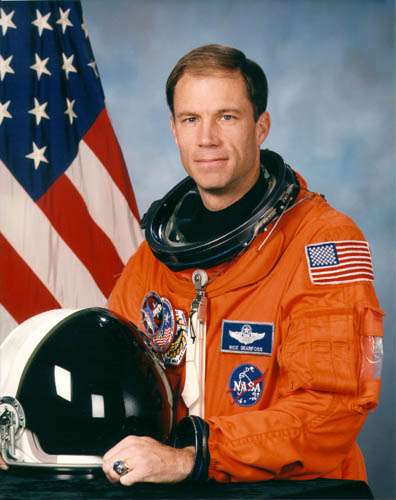Richard A. Searfoss
Richard A. Searfoss was an astronaut and retired U.S. Air Force Colonel. He piloted two space shuttle flights and commanded a third, spending more than 39 days in space.
Searfoss was born in Mount Clemens, Michigan, but considered Portsmouth, New Hampshire, to be his hometown. He earned a bachelor’s degree in aeronautical engineering from the U.S. Air Force Academy in Colorado and a master’s degree in aeronautics from the California Institute of Technology. In the Air Force, he flew F-111Fs in England, was an instructor pilot at Mountain Home Air Force Base in Idaho, and was a flight instructor at the U.S. Air Force Test Pilot School at Edwards Air Force Base in California before being selected as an astronaut candidate in 1990.
He logged more than 5,000 hours of flight time in 56 different aircraft and held FAA airline transport pilot, glider, and flight instructor ratings.
He finished his astronaut candidate training in 1991. He was a flight instructor at the test pilot school at Edwards Air Force Base when he got the call from NASA.
Searfoss first served as the pilot for the space shuttle Columbia on the STS-58 mission in 1993. STS-58 was the second dedicated Spacelab Life Sciences mission, and the crew collected more than 650 scientific samples from themselves and rodents that flew with them to help build a more comprehensive picture of how humans and animals adapt to weightlessness than had previously been available.
Searfoss piloted the space shuttle Atlantis on his second mission, STS-76, in 1996. The mission became the third to dock with the Russian Space Station Mir and delivered astronaut Shannon Lucid to it for an extended stay. Atlantis’ crew conducted the first spacewalk around two mated spacecraft and conducted a number of scientific investigations and engineering flight tests.
On his final spaceflight, Searfoss commanded the space shuttle Columbia for the STS-90 mission in 1998. It was the final Spacelab mission and focused on neuroscience. Searfoss and his crewmates served as the subjects and operators of 26 science experiments focusing on the effects of microgravity on the brain and nervous system.
After NASA, Searfoss remained active in the commercial space flight industry and was a test pilot for Xcor, a commercial space tourism firm based in Mojave.
The Church News interviewed him after the tragic loss of the Space Shuttle Columbia and its seven crew members in 2003.
- ”There is a human story here about the faith of the families," he said. "It is not up to us to know the details of God's ways or how He works, but I do know this: In spite of this terrible tragedy, the fact that men and women, people of faith, were so instrumental in making this mission go . . . will have a huge influence on people in the long run for good."
- Working at NASA is like working with people in the Church, he said. They become like brothers and sisters to you. "Your values come out," he said. "You need to rely on the Lord and have faith, not just for safety, but for doing your job up there.”[1]
Searfoss was 62 when he died at his home in Bear Valley Springs, California, on September 29, 2018. He and his wife, Julie, had three daughters. He was a member of The Church of Jesus Christ of Latter-day Saints.
